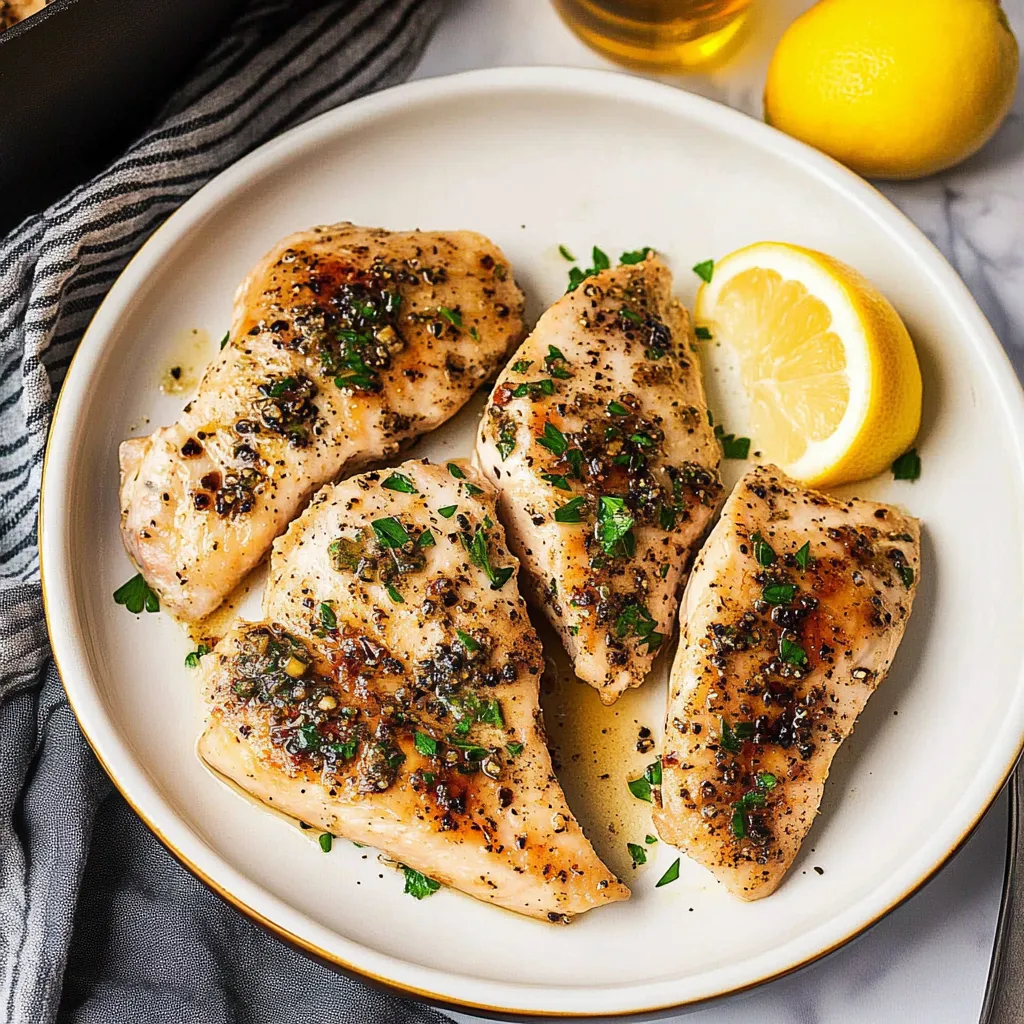 Pin it
Pin it
This garlic herb butter chicken transforms ordinary poultry into a restaurant-quality meal with minimal effort. The luxurious garlic herb butter melts into a silky sauce that coats each bite of tender chicken, creating a dish that feels special enough for company yet simple enough for weeknights.
I first made this on a rainy Tuesday when I needed something to brighten our mood. The incredible aroma filled our kitchen, and my husband actually thought I had ordered from our favorite bistro. Now it's our go-to impression dish when friends come over.
Ingredients
- Unsalted butter: Room temperature ensures proper blending with herbs. Choose high-quality European-style butter for richer flavor.
- Fresh parsley: Adds bright, clean flavor and beautiful color to the sauce. Always use fresh for this recipe.
- Herbs of choice: Thyme, rosemary, or tarragon all work beautifully. Select based on what complements your side dishes.
- Fresh garlic: The foundation of flavor. Look for firm bulbs with tight skin for maximum potency.
- Shallots: Provides a milder, more refined onion flavor than regular onions. Choose firm bulbs with no soft spots.
- Fresh lemon juice: Brightens the entire dish. Always use fresh-squeezed for the cleanest flavor.
- Chicken breasts: Select breasts of similar size for even cooking. Free-range or air-chilled options typically have better texture.
- Avocado oil: Has a high smoke point perfect for searing. Substitute any neutral oil you have on hand.
- Chicken broth: Creates the foundation for the sauce. Use low-sodium to control salt levels.
Step-by-Step Instructions
- Prepare garlic herb butter:
- Process all butter ingredients until completely smooth. This can be done up to three days ahead and refrigerated. If refrigerating, bring to room temperature for 30 minutes before using for easier melting.
- Season chicken:
- Apply salt and pepper generously on all sides of chicken. Proper seasoning is crucial for flavor development beyond just the sauce.
- Heat skillet:
- Allow pan to fully preheat before adding oil. A properly heated pan prevents sticking and ensures a golden crust forms on the chicken.
- Sear chicken:
- Cook undisturbed for proper browning. Resist the urge to move the chicken around which prevents proper crust formation. The first side always takes longer than the second.
- Rest chicken:
- Allow chicken to rest after cooking which redistributes juices throughout the meat ensuring maximum tenderness. Even five minutes makes a noticeable difference.
- Clean skillet if necessary:
- This step prevents burnt bits from giving your sauce a bitter flavor. The water deglazes without diluting your final sauce.
- Create sauce base:
- Reducing the chicken broth concentrates flavors and creates the foundation for your sauce. This step is where the magic happens as you capture all the fond from cooking the chicken.
- Incorporate butter:
- Add the herb butter gradually, whisking constantly to create an emulsified sauce. The sauce should coat the back of a spoon when properly reduced.
- Finish dish:
- Return chicken to the skillet briefly just to coat with sauce and rewarm. Avoid overcooking at this stage which would dry out the chicken.
 Pin it
Pin it
The shallots in this recipe are my secret weapon. I discovered their magic while taking a French cooking class years ago, and now I use them whenever I want to elevate a dish without much effort. The subtle sweetness they bring to this butter compound makes all the difference between a good dish and an unforgettable one.
Perfecting Your Chicken
The key to juicy chicken lies in avoiding overcooking. Chicken breasts are perfectly cooked when they reach 165°F internally or when the meat feels firm but still has some give when pressed. For foolproof results, consider butterflying thicker breasts or using a meat mallet to even out their thickness before cooking. This simple step ensures even cooking throughout and prevents dry edges while waiting for the center to cook through.
Herb Variations
While this recipe calls for herbs of choice, certain combinations work particularly well. For a classic French profile, try thyme, rosemary and a touch of tarragon. For Mediterranean flair, use oregano, basil and parsley. During summer months, I often incorporate fresh dill and chives for a lighter, brighter flavor profile. Remember that dried herbs are more potent than fresh, so if substituting, use one-third the amount called for.
Make-Ahead Options
This recipe includes several components that can be prepared in advance for even quicker weeknight meals. The garlic herb butter can be made up to one week ahead and stored refrigerated in an airtight container or formed into a log wrapped in parchment paper. You can even freeze the compound butter for up to three months. The chicken can be seasoned up to 24 hours in advance and kept covered in the refrigerator, which actually improves flavor development through dry brining.
Serving Suggestions
This chicken pairs beautifully with starchy sides that can soak up the incredible sauce. Consider serving over mashed potatoes, polenta, or rice pilaf. For a complete meal, add a simple green vegetable like roasted asparagus, sautéed green beans, or a crisp salad dressed with lemon vinaigrette. For a truly impressive presentation, place the chicken and sauce over a bed of wilted spinach and surround with roasted cherry tomatoes that burst with sweetness against the savory sauce.
Frequently Asked Questions
- → Can I use salted butter for the garlic herb butter?
Yes, but adjust the additional salt in the recipe to taste to avoid over-salting.
- → What herbs work best for the garlic herb butter?
Parsley, thyme, chives, or rosemary are excellent choices, but feel free to experiment with your favorites.
- → How do I know when the chicken is fully cooked?
Cooked chicken should reach an internal temperature of 165°F (74°C) and be firm to the touch with clear juices.
- → Can I make this dish ahead of time?
Yes, you can prepare the garlic herb butter in advance and refrigerate it. Cook the chicken fresh for the best texture and flavor.
- → What sides pair well with this dish?
Mashed potatoes, steamed vegetables, rice, or a fresh garden salad complement this chicken beautifully.
- → Can I substitute chicken breasts with thighs?
Yes, chicken thighs can be used for this recipe. Adjust cooking time accordingly, as thighs may take slightly longer to cook.
